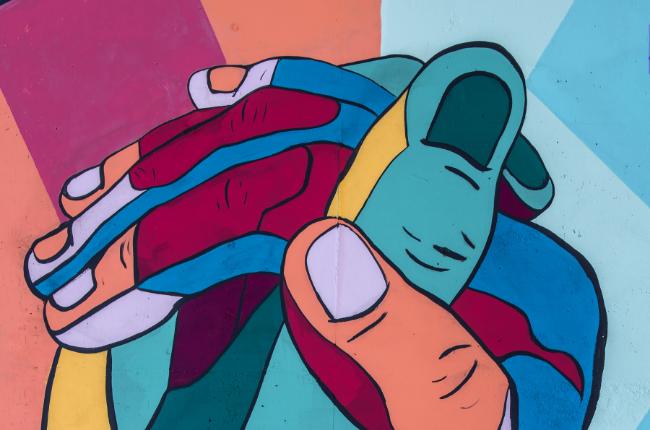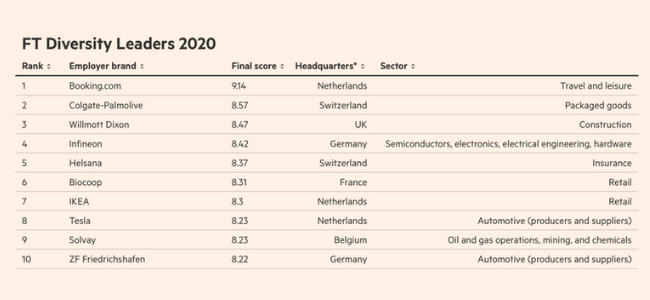The workplace of the (near) future will be diverse, inclusive and increasingly more representative of today’s society. Not because it’s trendy, but because the world is changing and the workplace needs to embrace it. Diversity fosters innovation and creativity, drives better financial performance, and provides an opportunity to unite people in their differences. Despite current efforts in companies, diversity is still viewed as a barrier to progression. However, in the years to come, it will emerge as a top business priority. But what needs to be done on both sides to make diversity at work the norm? How do we shift the mindset?

Diversity has been an increasing area of interest for both employers and employees over the past several years. This focus is driven by a few social phenomena:
- Populations keep evolving
- The Gen Z and millennial generations are the most diverse in history
- International migration creates new landscapes made up of mixed ethnicities and languages, and drives international marriages
- Globalization continues to rise and is accelerated by technology
- Fairness and equality are at the heart of human rights battles (e.g. women, LGBT, disability, etc.)
By 2025, 75% of the global workforce will comprise of millennials, meaning this group will represent the majority of leadership roles. They will be in charge of making important decisions that affect workplace cultures. This is good news for the future because this group has a unique perspective on diversity, as a result of varying experiences. Diversity and inclusion practices will eventually be a no-brainer, but we need to set the tone for diversity and inclusion awareness today. The workplace is already diverse — especially in terms of gender — but it’s not actively practicing inclusion in the day-to-day.
Diversity vs Inclusion
While most people are familiar with the terms “diversity” and “inclusion,” it’s worth recapping their definitions, considering diversity is broader than what we often assume:
What Is Diversity?
In the workplace, diversity refers to an organization that intentionally employs a workforce comprised of individuals of varying gender, religion, age, ethnicity, sexual orientation, education, and other attributes such as beliefs and values. Gallup defines diversity as “the full spectrum of human demographic differences”.
What Is Inclusion?
Inclusion refers to how people feel at work in terms of sense of belonging, involvement, development, empowerment and trust. A company’s workforce may be diverse; but, if employees do not feel safe, welcomed and valued, that company isn’t inclusive and likely isn’t performing to its highest potential. Simply put, inclusion is the degree in which employees feel valued, respected, accepted, and encouraged to fully participate in the organization.
An organization can be diverse but not necessarily inclusive. Some experts say diversity is about numbers; inclusion is about impact. As Vernā Myers, an American activist, says, “Diversity is getting invited to the party. Inclusion is being asked to dance.”
Employers have the transformative power to change and contribute to a more open, diverse and inclusive society. Employees have the power to educate employers about diversity and inclusion by sharing positive and inspiring stories. Is power sufficient? Do we need to assess the measurable benefits of diversity and inclusion to prepare for the future to make these principles a top priority?
Measurable Business Benefits
According to a global PwC survey, the primary objectives of diversity and inclusion at work are to attract and retain talent, but also to achieve business results. In fewer cases, objectives are to comply with legal requirements, to enhance external reputation or to respond to customer expectations. Whatever the objectives are, diversity in the workplace has several tangible benefits for companies — and actually only has advantages. Diversity reduces the employee turnover rate, thereby making significant savings in employment and training costs. Plus, when diverse employees are united with a common purpose, conflicts are reduced and collaboration and engagement increase, driving additional benefits to the business. In a global McKinsey survey, companies in the top quartile for ethnic diversity were found to be 35% more likely to have financial returns above their respective national industry medians.
“Will they fit in with the team?” is something you may have thought or heard if you’ve been involved in the recruitment process at your company. This is a discriminatory statement as it implies the company wants to be surrounded by people who look and think like us. Employers should not look at differences as a weakness, but as a strength. Differences can actually help unite people, especially if they are working towards a common goal. “United in diversity” is an underlying principle of the European Union and shows that unity can and should exist in diversity.
Some companies are leading the way in practicing diversity and inclusion. Financial Times and Statista conducted a Diversity Leaders survey, ranking 700 companies in 10 European countries around diversity and inclusion in the workplace. The ranking shows that diversity is practiced across countries and sectors, suggesting it is a pure Corporate individual decision, rather than a legal requirement. These efforts are remarkable and should be used as examples to drive more diversity in the workplace.

Some organizations even provide comprehensive diversity training for all employees. These trainings can include cross-cultural communication, multicultural and multi-ethnic understanding, and inclusive management. While these trainings are still marginal overall, they will become more and more the norm.
Diversity Benefits Employees
I don’t like to think of diversity and inclusion only as a business opportunity. Diversity provides huge benefits to any employee working in a diverse and inclusive culture. Diverse teams solve problems more effectively and are more likely to challenge the status quo together and, therefore, develop breakthroughs.
An increasing number of job seekers consider workplace diversity an important factor when looking for employment opportunities. Employees understand that diversity has many short and long-term benefits when it comes to satisfaction, motivation, perception and inclusion of differences. Being exposed to a diverse team not only offers new perspectives, but also can act as a conduit for personal and professional growth.
There are sometimes discrepancies between what companies claim and the day-to-day reality. A simple tip before joining a company is to check the “People” section of the company’s LinkedIn page. While not everyone at the company will have a LinkedIn profile, glancing through the list of employees – especially in management positions – to get a good sense of the type of people the company hires and if there’s diversity. The company’s mission statement, available on the website, should also give you a good sense of their diversity and inclusion approach.
A lot of employees seem to have received the message that both soft and hard skills are relevant to remain employable in the future. Diversity is the cornerstone of this duality and is increasingly promoted in job vacancies. Diversity skills are crucial to put forward to show how you can adapt in a diverse work environment. Employees should be proud of showcasing these skills as it will help them stand out, both at recruitment stage and once they’ve joined the company.
Diversity in Marketing and Communications
I work as one of the Global Hub specialists at LEWIS. I have French and Moroccan roots; I live in Germany, and I married an Uyghur (a Turkic-speaking ethnic minority of China). International culture is part of my DNA. My role involves daily interactions with teams and clients around the world. I’m at the heart of diversity in terms of cultures, languages, working styles, etc. Working with teams across the globe makes my job much richer and much more inspiring. Think about it. Even the food we eat every day is a result of this mix of cultures. Globally known musical genres, such as jazz, rock ’n’ roll, RnB and hip-hop, are the products of cultural blending. As globalization and technology continue to develop, our work will drive more and more innovation that is inspired and led by diversity. And perhaps new words will even emerge to define this melting-pot.
In our marketing and communications world, we see the benefits of diversity every day. We brainstorm with a very diverse group of people – each of them bringing interesting perspectives. We learn best practices from others and we feel united as part of ONE big team. Diversity helps us manage complex tasks for clients, deal with uncertainty (e.g. linked to the economic situation) and shape the meaning we give to our work.
As a consultancy, we can also advise our clients on how they can adopt a diverse marketing strategy – from their website to messaging and imagery. An important point here is that diversity can mean different things to different organizations. Diversity should not be a one-time campaign, but a core element of a brand’s long-term values and mission. Businesses can embrace diversity, not only to build a great reputation, but to foster innovation and creativity that ultimately results in a competitive advantage.
Changing the Mindset
Not all countries are at the same stage in terms of practicing diversity, but it all starts with awareness. If employers and employees treat diversity and inclusion as a key value – from recruitment to retention – having some knowledge of cultural differences, keeping an open mind, practicing active listening and watching for nonverbal communication will come naturally.
It’s also important to be transparent with employees about why diversity skills in the workplace make a difference. If employers convey rationale with conviction and practice inclusive management (e.g. combatting stereotypes), individuals and teams will experience a shift in their own mindset.
The more exposed we are to diversity, the more we can expand our minds. Given all the differences that exist today, diversity and inclusion shouldn’t be a question of “if,” but of “how.”
Here are a few stats about diversity:
- General: Cultural and ethnic diverse teams outperform compared to non-diverse teams by 36% (McKinsey).
- Language: There are over 6,500 languages spoken in the world, including 2,300 in Asia, 2,000 in Africa and about 200 regional and minority languages in the European Union.
- Ethnicity: By 2051, researchers project ethnic minorities will make up 20% of the British population. And by 2045, white people will be a minority in the US.
- Religion: It is predicted that by 2044, one-third of Europe will be Muslim. And by 2030, Muslims are projected to represent about 26.4% of the global population.
- Age: By 2050, one-third of the European population is expected to be 65 years old or older. Also, 83% of millennials are more engaged when they think their company fosters an inclusive culture.
- Gender: In the US and Europe, women make up more than 45% of the workforce, but hold only 24% of senior roles.
- Education: In 2050, at least 90% of the student population will be pursuing online degree programs. Education will be truly democratized and globalized, with students unhindered by age, social, geographical or national boundaries.
These statistics show that diversity is something to embrace and promote in order to build strong foundations for millennials and for our children. Of course, it takes vision and leadership to drive diversity.
I spoke to Tatjana Krajsic, keynote speaker and promoter of diversity in the workplace, who said:
To drive diversity at work, we first and foremost need to create a safe space for employees. In a so-called psychologically safe space, people will contribute with their ideas – as unique and even quirky these ideas may be. Because when we find ourselves in an environment that encourages play and where trial and error is allowed, we will feel comfortable to speak up, we will be happily contributing with ideas and we will even express contrarian views,’ she further adds. ‘So, we need to ask ourselves if the right conditions for people to have been planted so they are comfortable sharing diverse thoughts. And whether people are being respected for their differences or are rather being rejected for their individuality.
Tatjana continues,
However, if we find ourselves in a place that is rather led by fear – may this be related to the fear of making mistakes, the fear of not belonging or the fear losing our job – this fear will certainly shape the decisions we make. Because the moment we feel threatened, whether this is an emotional or a physical threat, we tend to move into spaces that provide us safety. This can potentially mean that we surround ourselves with like-minded people. And when this happens, we will surely see a decline in diverse and different idea contributions.
Tatjana further adds,
Workplaces of the future need to create simple communication principles that promote inclusion so that people don’t have fears anymore but instead feel comfortable and respected for their individuality. And in order to stay competitive in the market, companies need diverse teams that bring broader ideas and new perspectives to the table.
Last summer, Tatjana shared further thoughts on the topic of “Embracing Diversity” at her SheSays online talk.
I’m proud to work at a company that sees diversity, inclusion and equality as core Corporate values – read more on this below – and hope that in the coming years, diversity and inclusion will be practiced more widely.
Find out more about LEWIS culture. What is your experience with diversity and inclusion at work?
***TEAM LEWIS is an Equal Opportunity Employer, counting a minimum of 24 different nationalities and 69% female / 31% male workers and including a high share of women in leadership roles. We are committed to creating and fostering an environment focused on equality, empowerment and respect. We strive to create an inclusive workplace that supports and celebrates our diversity. We continue to invest in our efforts to ensure that LEWIS is a place where everyone can thrive.***



